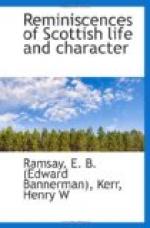On Deeside, where many original stories had their origin, I recollect hearing several of an excellent and worthy, but very simple-minded man, the Laird of Craigmyle. On one occasion, when the beautiful and clever Jane, Duchess of Gordon, was scouring through the country, intent upon some of those electioneering schemes which often occupied her fertile imagination and active energies, she came to call at Craigmyle, and having heard that the laird was making bricks on the property, for the purpose of building a new garden wall, with her usual tact she opened the subject, and kindly asked, “Well, Mr. Gordon, and how do your bricks come on?” Good Craigmyle’s thoughts were much occupied with a new leather portion of his dress, which had been lately constructed, so, looking down on his nether garments, he said in pure Aberdeen dialect, “Muckle obleeged to yer Grace, the breeks war sum ticht at first, but they are deeing weel eneuch noo.”
The last Laird of Macnab, before the clan finally broke up and emigrated to Canada, was a well-known character in the country, and being poor, used to ride about on a most wretched horse, which gave occasion to many jibes at his expense. The laird was in the constant habit of riding up from the country to attend the Musselburgh races. A young wit, by way of playing him off on the race-course, asked him, in a contemptuous tone, “Is that the same horse you had last year, laird?” “Na,” said the laird, brandishing his whip in the interrogator’s face in so emphatic a manner as to preclude further questioning, “na; but it’s the same whup.” In those days, as might be expected, people were not nice in expressions of their dislike of persons and measures. If there be not more charity in society than of old, there is certainly more courtesy. I have, from a friend, an anecdote illustrative of this remark, in regard to feelings exercised towards




